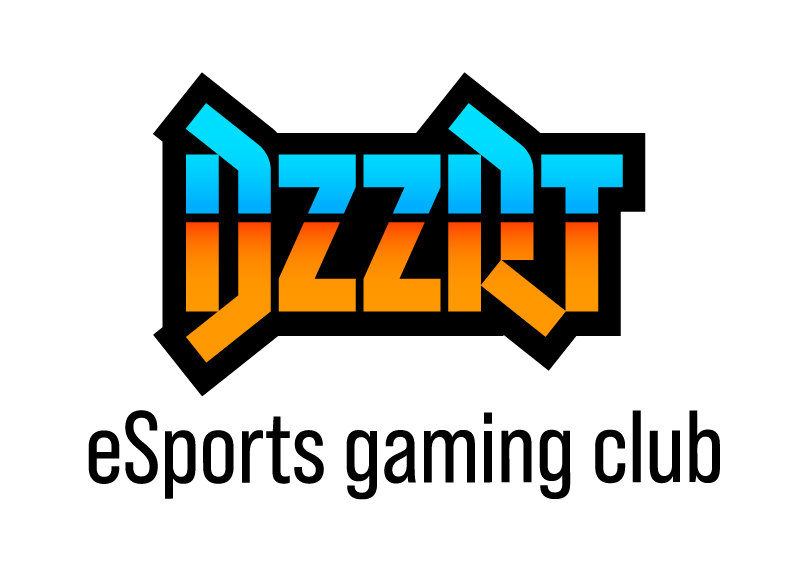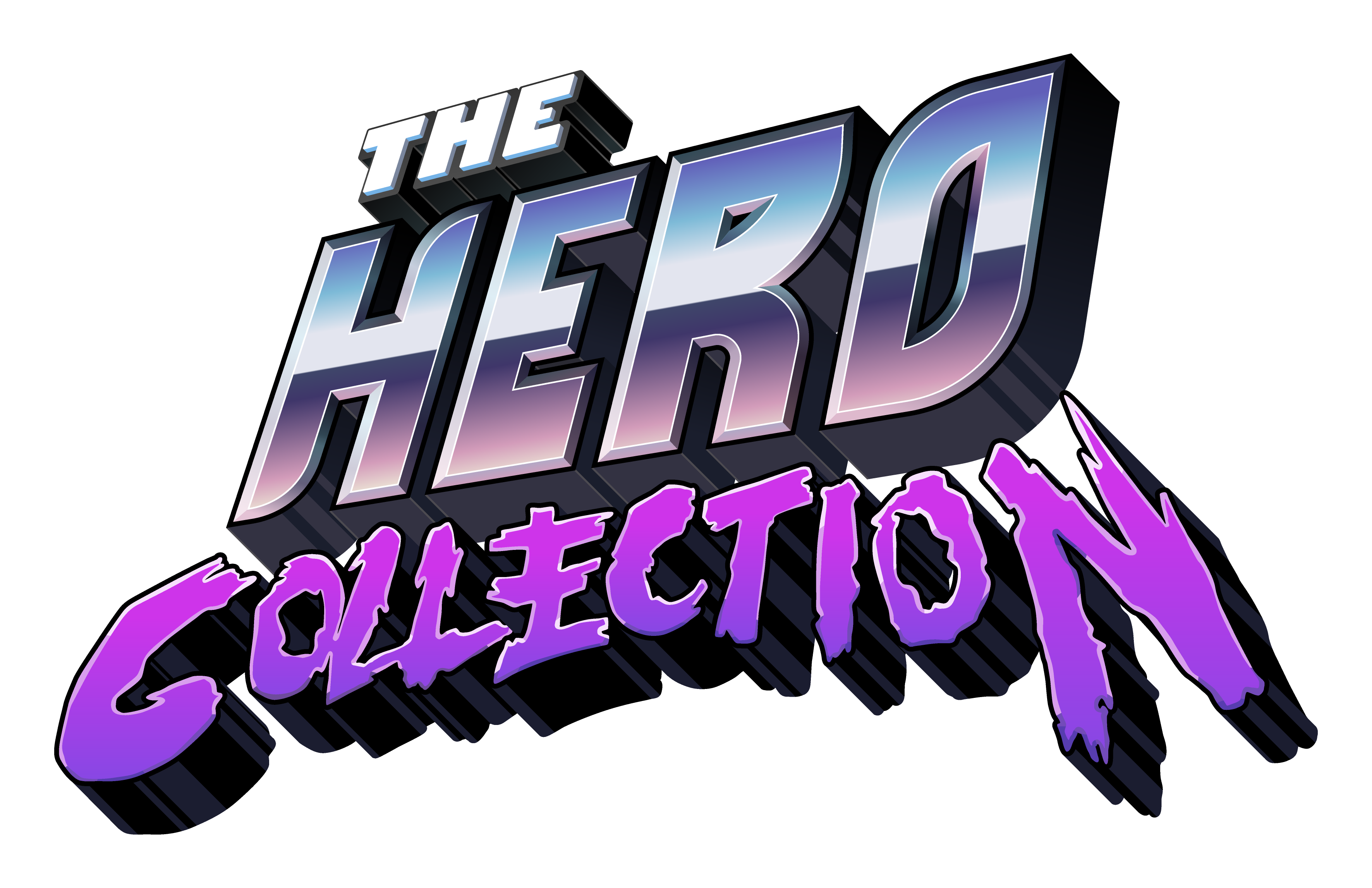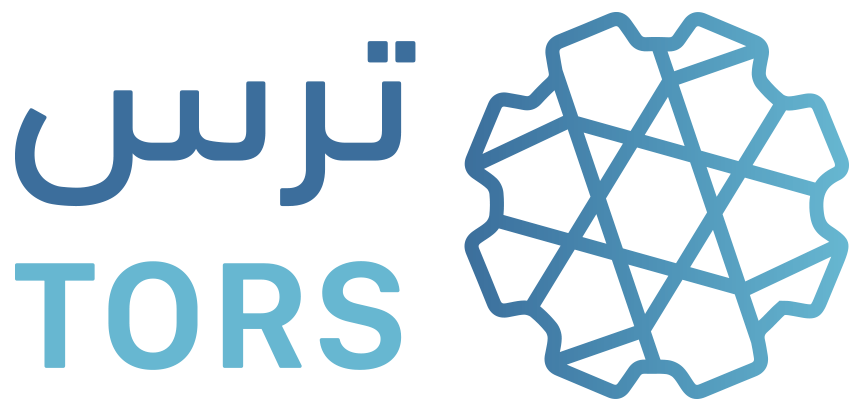is part of the Informa Markets Division of Informa PLC
This site is operated by a business or businesses owned by Informa PLC and all copyright resides with them. Informa PLC's registered office is 5 Howick Place, London SW1P 1WG. Registered in England and Wales. Number 8860726.
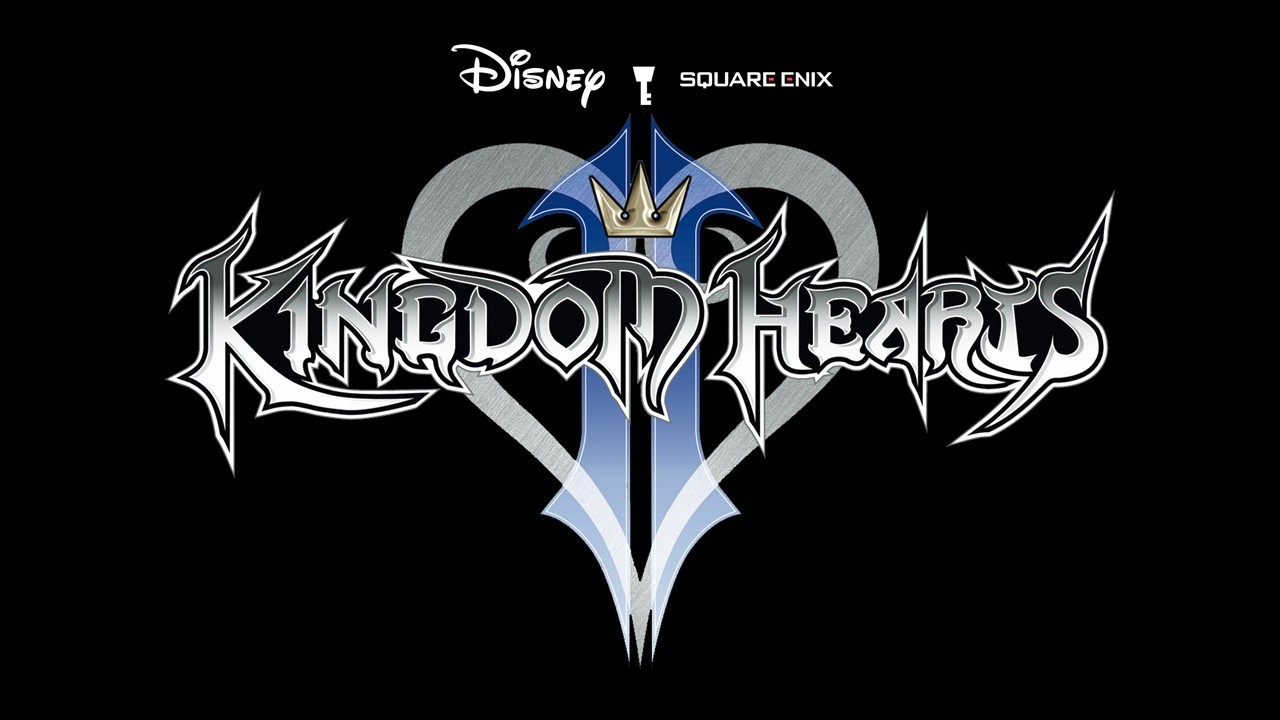
CONTEXTUAL AND PUBLICATION HISTORY
The Kingdom Hearts franchise caters to the once popular Japanese Role-Playing Games genre. While standard JRPGs have used the Turn Based system as a form of gameplay, Kingdom Hearts diverged into a more modern approach to RPGs; Action Role-Playing, where the player would undertake a more active role in the character’s story and actions. This type of genre was fairly new for JRPGs when the first Kingdom Hearts game was released; 28th March, 2002, published and developed by a collaboration of Square Enix (formerly known as Square, before merging with Enix) and Disney Interactive Studios. This collaboration was purely coincidental when a meeting between one of the main designers of Square, Shinji Hashimoto, and a Disney executive took place in an elevator by chance, because both companies occupied the same building. The concept of rivaling the popularity of Super Mario 64 is what led to the creation of Kingdom Hearts, utilizing the popularity of Disney and Final Fantasy characters. Tetsuya Nomura, director of the Kingdom Hearts franchise, had previously worked on Final Fantasy titles like Final Fantasy VII as a character designer, which meant that Kingdom Hearts was his directorial debut. The aim of the game was to be as successful, if not more, than the Final Fantasy franchise. While the target audience was Disney age appropriate, the inclusion of tactics and an epic story bode well with a young adult audience as well resulting in the first title of the franchise, Kingdom Hearts 1 being “Playstation 2’s 9th best-selling game of all time”
With the worldwide success of the game and the presence of a secret ending that hinted towards sequels or prequels, the Kingdom Hearts franchise expanded. Sequels like Kingdom Hearts: Chain of Memories and Kingdom Hearts 2 were developed and published not long after the release of the original game. The story of the franchise is well spread out over the course of 7 games in total so far. It revolves around the character of Sora, the protagonist and his journey to rid the various worlds of darkness and evil. He is joined by original characters, Riku and Kairi, as well as Disney’s classic characters, Donald, Goofy and Mickey, along with cameos by various well received and popular Final Fantasy characters like Cloud Strife from Final Fantasy VII and Squall Leonhart from Final Fantasy VIII. This storyline, of saving the worlds from darkness and the various forms of Xehanort
(Xemnas and Ansem) is carried over to the prequel, where Sora was only a 5 year old boy. This particular prequel and the events followed in this game were hinted at in both main titles of the franchise, Kingdom Hearts 1 and Kingdom Hearts 2. The events went as follows; before Sora, there were multiple Keyblade wielders, which ultimately resulted in the Keyblade War between light and darkness and people who wanted to create an X-blade. Not only does the prequel, Kingdom Hearts: Birth by Sleep, explain in detail what happens in the Keyblade War, it also explains how Apprentice Xehanort came to be and thus leading to the creation of the villains in the main game titles. This game diverged from having Sora and/or people related to him as the main characters.
Kingdom Hearts: Birth by Sleep was released on 10th September, 2010, worldwide; however the original Japanese version was released months prior; 9th January 2010. Being released on the Playstation Portable (PSP original), this game was the second game of the franchise to be released on a handheld console; the first being Kingdom Hearts: Chain of Memories on the Gameboy Advance. Once again, Tetsuya Nomura took directorial lead along with co-director, Tai Yasue. Development of the game started in 2005, soon after the release of Kingdom Hearts 2, where this game was heavily referenced by including a secret boss battle between Terra and Sora. The creators stated, that while Kingdom Hearts: Birth by Sleep was not a main title in the franchise, it held the same level of importance and key factor in story as the main titles Kingdom Hearts 1 and Kingdom Hearts 2 did and was thus dubbed Kingdom Hearts: Episode 0
LEVELS AND CONTEXT: PLATFORM
Kingdom Hearts: Birth by Sleep was originally released on the Playstation Portable; however an HD remake will soon be released on the Playstation 3 in a compilation form, called Kingdom Hearts: HD 2.5 Remix. The Kingdom Hearts franchise has always been released on either Sony consoles or Nintendo handhelds. The reason Kingdom Hearts: Chain of Memories was released on Gameboy Advance, was that majority of the gaming audience had taken a liking to the trend of handheld, on the go gaming. This was a factor that was taken into account when deciding that the game was going to be on the PSP, because originally, the game was expected to be on the Playstation 2. The main reason, however, for the switch between PS2 and PSP, was because the creators wanted to give co-operative play and competitive multiplayer a try, and the PSP allowed that.
The Playstation Portable was released worldwide on 1st September, 2005, with production beginning in mid-2002. This console was Sony’s first attempt at a handheld, following in the footsteps of Nintendo’s success with their respective handhelds. While the console was released a while before the release of Kingdom Hearts: Birth by Sleep, this game is still regarded as the most anticipated title of the PSP. The distinction between the PSP and other handhelds at the time was that the PSP was much more graphically enhanced, along with having a much wider screen, easier user interface and the first handheld to have the ability of multimedia capabilities.
The external outlook of the PSP was similar to the Gameboy Advance following the slab format, allowing the screen to extend to 4.3 inches which allows 480 x 272 pixel video playback (Wikipedia). The handheld interface remained very similar to the Playstation standard format, using the triangle, square, circle and X buttons along with a joystick that would allow 3D movement. The PSP uses one 333 MHz MIPS32 R4000-based CPU, a GPU with 2 MB onboard VRAM running at 166 MHz, and includes 32 MB main RAM and 4 MB embedded DRAM in total (Wikipedia).
The console was received well by the general audience and critics alike. It was praised by critics for being on par with the Playstation 2 in terms of graphics and for also being one of the first handhelds to hold Wi-Fi options along with allowing storages of different media, like videos and music etc.
GAME CODES
Game codes for console or handheld games in general are never released because they are encrypted and are usually not in need of modifications. According to the creators, recreating Disney’s famous characters in 3D was always a challenge but with the developing graphics engine it became possible. Reportedly, Kingdom Hearts: Birth by Sleep uses Crystal Engine for graphic development but there has not been an official record of this. Similarly, no record is shown of the game code ever being released for the public as this game does not require any mods or custom content. However, people have managed to crack the game to create an emulated ROM for the PC and have thus, allowed people to be able to create codes for Action Replay, Code Breaker and Gameshark to cheat in the game.
GAME FORM (AND FUNCTION)
In Kingdom Hearts: Birth by Sleep, the player controls three different characters as opposed to its predecessors; Terra, Aqua and Ventus. The main plot revolves around Terra, Aqua and Ventus’s journey to locate the missing Master Xehanort, who is a friend of their teacher, Master Eraqus (a pun on the word Square). This quest takes place 10 years prior to the setting of Kingdom Hearts 1. The main problem faced by most sequels and prequels for games, is that players wonder where these newly introduced characters were in the previous games, but Kingdom Hearts: Birth by Sleep avoids that issue by storytelling and how each of the main characters in the game met their tragic end and thus giving proof of their absence in the games that follow the timeline chronologically.
As mentioned before, Kingdom Hearts: Birth by Sleep is an action role-playing game and thus requires a combat system that would complement real time action. Since the first Kingdom Hearts game, the combat system has been updated with each game and contains major differences in technique from the former. Kingdom Hearts: Birth by Sleep uses the Command Deck system, which allows the player to customize the various battle strategies that can be used to defeat particular enemies. Using these Command Decks fills up a gauge which allows the player to use Command Styles, which is a completely new concept to the franchise. Filling the gauge with certain Commands allows the player to use different combinations of Command styles.This game, unlike the previous games, also introduce s the use of Focus and Dimension Link. D-link is used for calling upon help from characters similar to Summons in Kingdom Hearts 2. Focus on the other hand is a replacement for Magic Points in previous games. This allows the player to use a very powerful finisher exclusive to each different character. Players can also provide themselves a challenge by not using Command Styles or Command Decks. Kingdom Hearts: Birth by Sleep was praised for its combat system because it was the most developed and aesthetically appealing one out of the series.
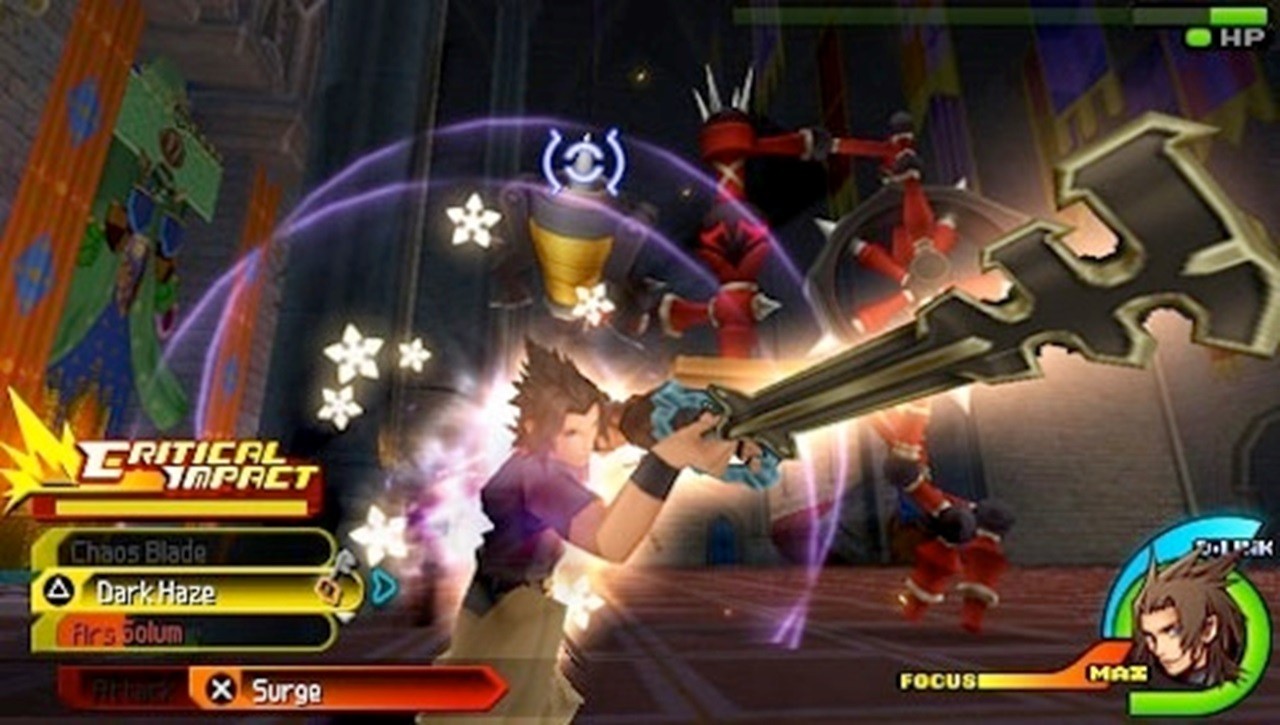
This picture demonstrates Terra using the Command Style Critical Impact
INTERFACE
The basic of interface is through coding, by allowing the player to press certain buttons to obtain certain results or combination of results. In Kingdom Hearts: Birth by Sleep, the player uses the X button to attack normally while using the Triangle button to use Command Decks. The X button can also be used to interact with different objects and people while the Circle button is used for jumping. The Square button is used to guard or defend while the analogue stick is used to move the character around. This system would allow every player to have the same dynamic in the game, but the Command Deck allows each player to have a different style of play.
The Command Deck menu acts as the main interface between the character and the player. This allows the player to make their own deck suited to what element or what style they prefer fighting with; whether it is offense or defense or if it is physical attacks or magic attacks.
Along with the main Command Deck menu, there are several other menus in the game that allow the player to interact with the game for example, the Start menu, the Shop Menu or the Battle Design. Using these menus the player can control every aspect of their character, ranging from what
attacks they can use to items that can be purchased and more.
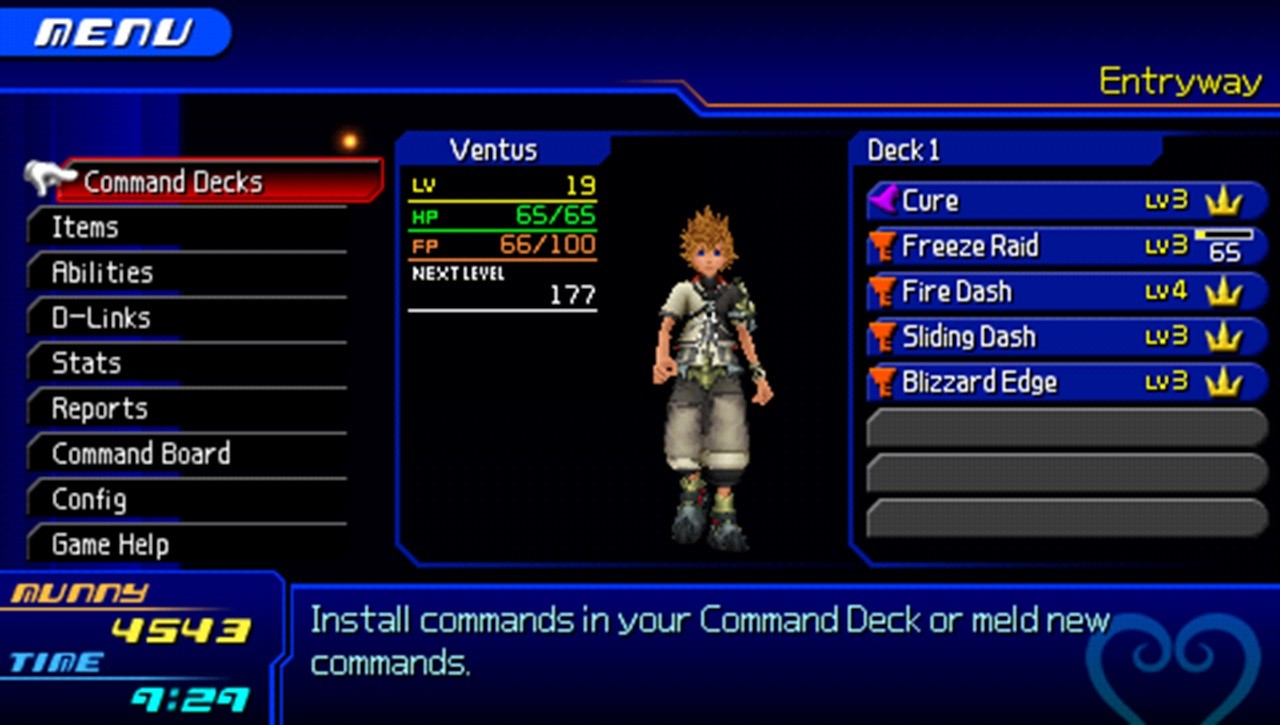
This image is an example of The Battle Design Menu, where the player can alter abilities and stats of the character
INTERFACES AND GAME TREES
While Kingdom Hearts: Birth by Sleep does not offer much diversity and different outcomes in terms of story, it does offer the player a chance to choose which character’s scenario they wish to play first. Terra, Aqua and Ventus all have different storylines based on the same universe and therefore have different end results and different takes on what is moral and immoral. There is no chronological order to play but it is preferred to be played in the order of Terra > Ventus > Aqua, because the former’s story ends earlier in timeline than the latter’s.
Also, as stated before, a player can choose which form of attack mode each character will use; whether they are more profound in attack, defense or magic. By default, Terra specializes in attack, Aqua in magic while Ventus uses both. This could also be a determining factor for the player to choose which character to play as first. Furthermore, the player can also decide which worlds to visit first. For example, both the Dwarf Woodlands from Snow White and the Seven Dwarfs and Enchanted Dominion from The Sleeping Beauty are available to visit when the player starts the game. The story is then adjusted to the choice of the player depending on which world is visited first.
RECEPTION AND OPERATION
Prior to the release of Kingdom Hearts: Birth by Sleep, Jump Magazine and Famitsu provided spoilers that were released on a monthly basis on approval of Square Enix. These spoilers provided the game recognition to readers of the magazine. Along with physical advertisements, digital advertisements were far more effective. The game was, as stated before, referenced in Kingdom Hearts 2 and so the public was already looking forward to another installment in the Kingdom Hearts franchise. The game was officially announced at the Tokyo Game Show in 2007, which led to the release of a series of trailers and gameplay videos leading up to the release of the game. The final appearance of the game before the actual release was at Jump Festa 2009, where a demo of the game was released, allowing renowned game reviewers to provide feedback on the game.
Overall, the game was well received by critics and gamers alike, selling over 500,000 copies. By the end of 2010, it was listed as the sixth best-selling video game in the United States. Websites like Gamespot, IGN and Gamezone provided their own feedback on the game. Gamespot gave the game a review of 7.5/10, stating that while the combat system and story in Kingdom Hearts: Birth by Sleep might have some repetitions, “vibrant visuals and snazzy, evolving combat will likely charm fans and newcomers alike into forgiving most of the flaws” (Gamespot). IGN, however, provided a more positive review than Gamespot giving the game an 8.5/10, stating that Birth by Sleep is worth the money and the wait and that the battle system is the best in the series (IGN).
PERSONAL OPINION
Being a fan of traditional turned base JRPGs, I started playing Kingdom Hearts solely because of the presence of Final Fantasy characters like Cloud Strife. I did not play the games in chronological order, as I started with Kingdom Hearts 2, which was a pleasant surprise and led me to become a fan of franchise, picking up all the related games in order to keep up with the story. This is what led me to play Kingdom Hearts: Birth by Sleep. I bought the PSP solely for this game and Final Fantasy VII: Crisis Core.
What intrigued me most about this game was the combat system. Unlike the previous games, this combat system was flashier and more aesthetically gorgeous. Admittedly, Sora in the previous games had just started out as a Keyblade Wielder, which is why it would make sense that he did not have as much experience with tactics and fancy commands. The fresh experience of controlling a female character was also a perk of this game. While the previous games had the potential to explore controlling Kairi, it was never done and so controlling Aqua and being able to focus more on magic as opposed to the attack norm was also a great advantage of the game. Personally, this is my favorite game of the franchise, because this game separates itself from the main happy-go-lucky theme of the Kingdom Hearts franchise. This game has a somber and depressing tone to it, because the player can figure out the fates of each character, and the game, by the end, invokes pity from the player towards the characters that do not exist in real life. While this may not be the most realistic game, the theme of darkness versus light (good versus evil) is a very common topic in real life. Unlike previous games, the mini games in Kingdom Hearts: Birth by Sleep were very enjoyable, especially the Command Board Mini game, which had a similarity to monopoly.
The cons of this game, however minor they are, are still a little bit painful to watch. Some of the voice acting, particularly Terra’s, sounded clichéd, forced and not realistic at all. Certain retcons were present in the game which made it confusing for some players. For example, when Donald and Goofy visit Mysterious Tower in Kingdom Hearts 2, they do not recognize it, however, in this game, which takes place 10 years prior, Donald and Goofy are stationed at Mysterious Tower to help King Mickey and Yen Sid. The retcon was passed as Yen Sid “redecorating” the tower and that is why Donald and Goofy did not recognize it.
Overall, I would say this game has lead the Kingdom Hearts franchise into a great direction, opening up possibilities of multiplayer, beautiful combat system and great new characters that are older and wiser than the ones we are used to playing as. The story has also become more rich and interesting than it was before with the idea that at the end of the franchise Sora is the key and he has the power to save the characters of this game from their tragic fate.


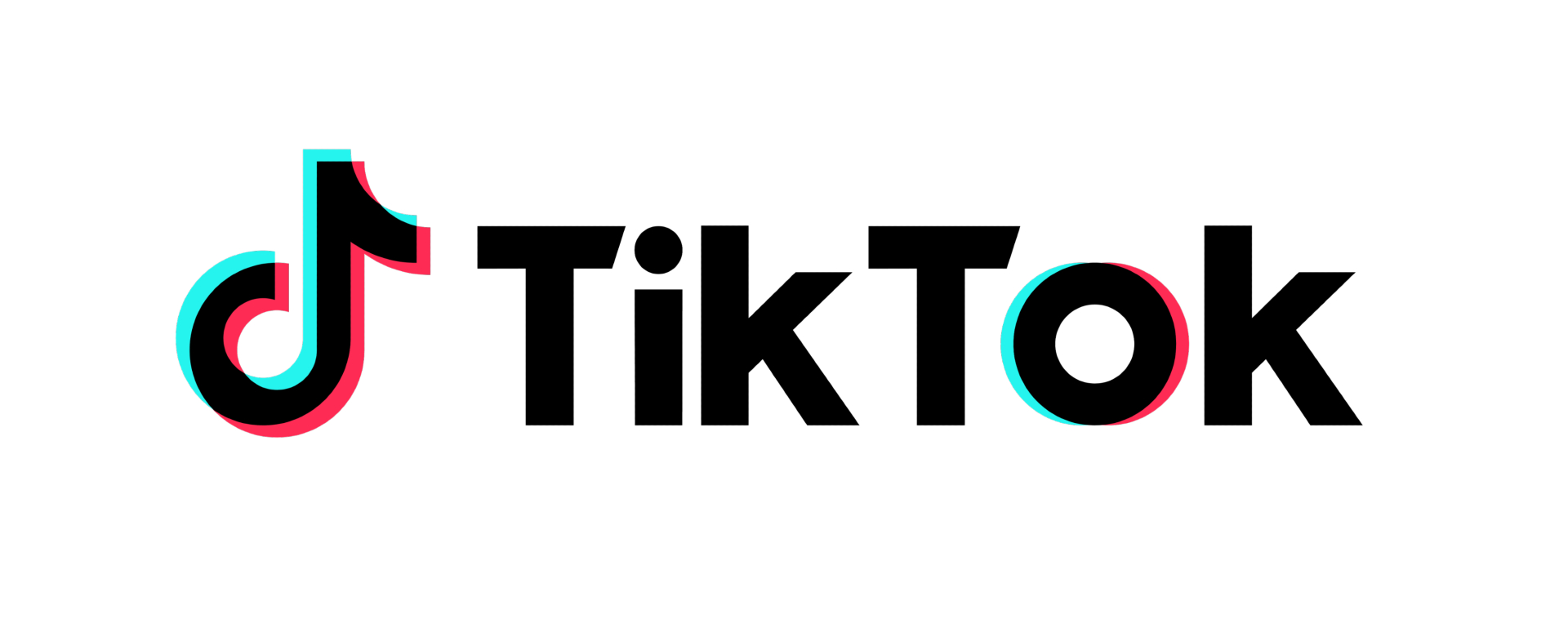

.png)
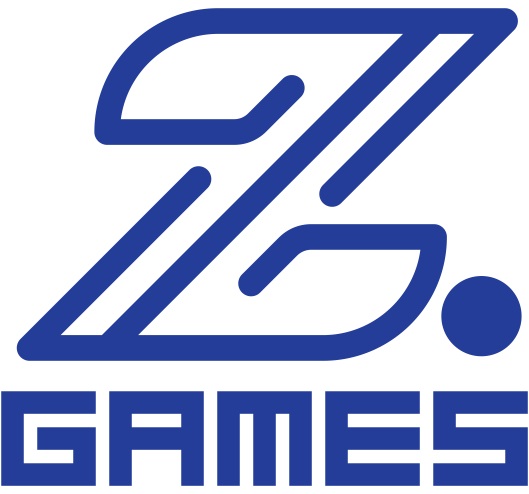

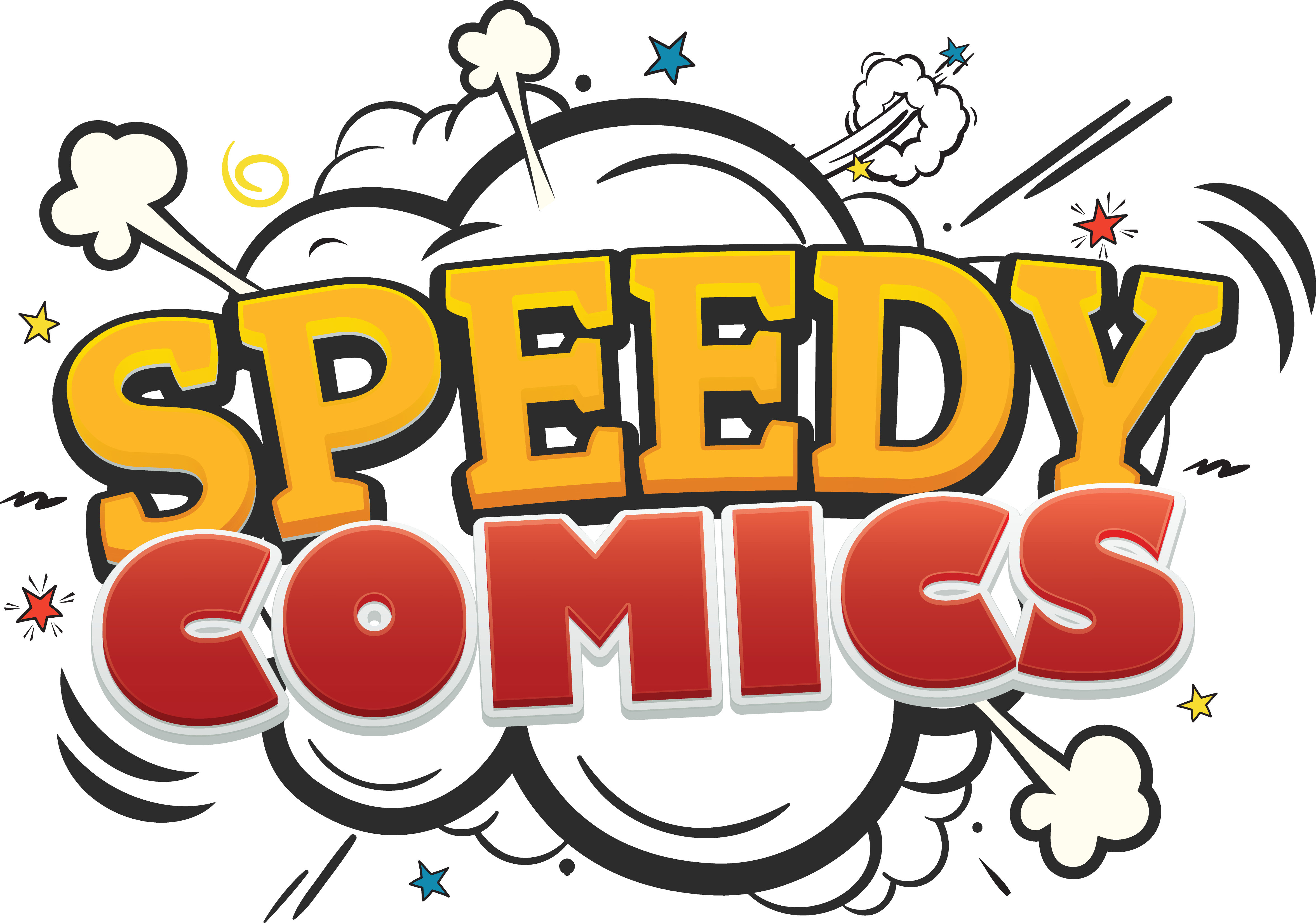



.png)



